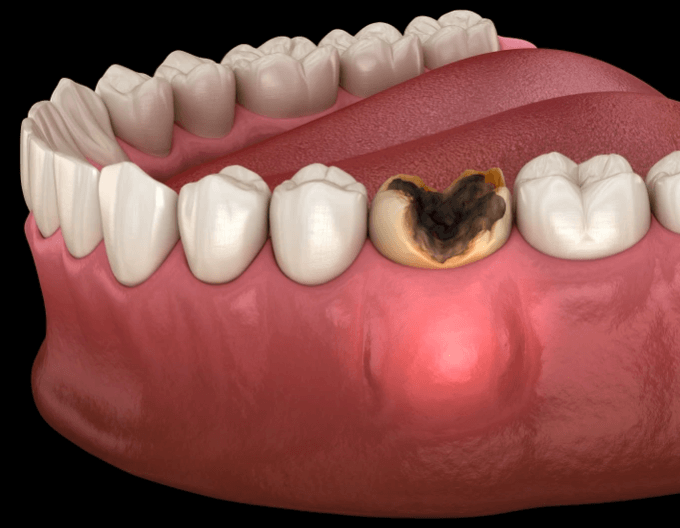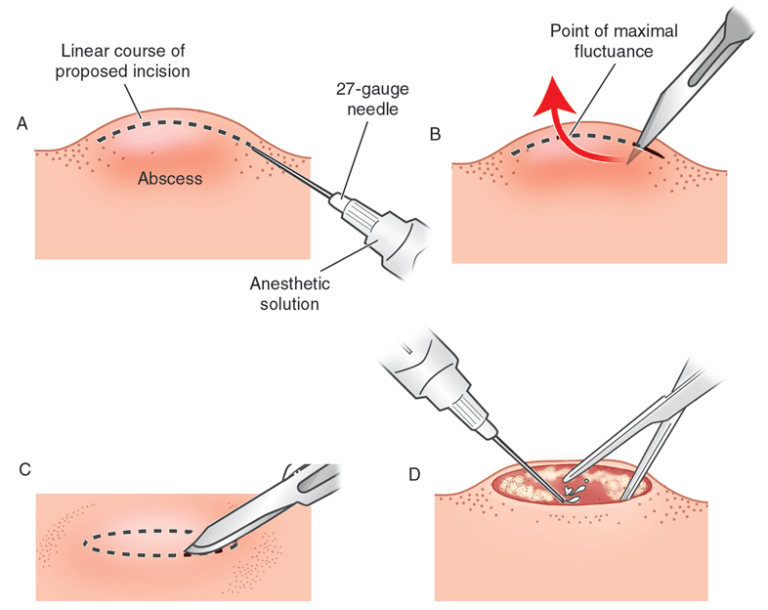Abscess Drainage

What Is Abscess Drainage?
Abscess Drainage, also called Incision & Drainage, is a common dental procedure used to relieve pain and clear out infection from a Dental Abscess. A Dental Abscess is a painful collection of pus caused by a bacterial infection, often leading to swelling in the gums, cheeks, or near the tooth itself. Left untreated, a dental abscess can spread to surrounding gum and bone, leading to serious complications—even becoming life-threatening. During the procedure, your dentist will numb the area with local anesthesia and make a small incision to allow the pus to drain. This not only alleviates the pain and pressure caused by the abscess but also helps speed up your body’s natural healing process.
It’s important to treat a dental abscess as soon as possible to prevent the infection from spreading to other areas of the body, which can lead to serious health issues. Here’s what you need to know before deciding if Abscess Drainage is right for you:
- Who Needs Abscess Drainage?
- Benefits Of Abscess Drainage
- Risks If You Do Not Get An Abscess Drained
- Alternative Treatments To Abscess Drainage
- How Much Does Abscess Drainage Cost?
- Steps In The Abscess Drainage Procedure
- Frequently Asked Questions About Abscess Drainage
If you have any further questions about Abscess Drainage or other dental services offered at Atlas Dental, please contact us.

Free phone consultation
Have questions about a dental abscess? Schedule a free phone consultation with our Toronto dentist.

5 star google reviews
See for yourself why more and more people are choosing our dental office for dental abscess treatment.

Emergency dental care
Have a dental abscess in Toronto and think you need it drained? Book online for same day exam and treatment.
Who Needs Abscess Drainage?
Anyone can develop a tooth abscess, regardless of age or oral hygiene. It often results from untreated tooth decay, gum disease, or a failed root canal. Here are some common signs that you may need abscess drainage:
- Severe Tooth Pain: Intense and persistent tooth pain is a major sign. The pressure from pus buildup can cause pain that radiates to the jaw, neck, or even ear.
- Swelling: Swelling in the gums, face, or jaw, often accompanied by redness, signals an abscess.
- Fever and General Malaise: Fever, chills, and feeling unwell are systemic signs that the infection may be spreading.
- Difficulty Swallowing or Breathing: In more severe cases, the swelling may make it hard to swallow or breathe.
- Bad Taste or Bad Breath: A foul taste in your mouth or bad breath from draining pus can indicate an infection.
- Visible Pus Accumulation: A visible pus-filled bump in the mouth is a clear indication of an abscess.
- Tooth Sensitivity: Sensitivity to hot, cold, or pressure might suggest an abscess near the tooth root.
If you experience any of these symptoms, don’t delay. Seek immediate dental care to prevent more serious health complications. If you have further questions about draining an abscess, please contact us.

Benefits Of Abscess Drainage
Abscess drainage offers several key benefits for treating oral infections:
- Immediate Pain Relief: Draining the abscess relieves pressure, providing quick relief from the severe pain caused by the infection.
- Reduced Swelling and Inflammation: By removing the source of infection, drainage helps reduce swelling, which improves both comfort and appearance.
- Prevention of Serious Complications: Treating an abscess early can prevent the infection from spreading to other tissues or even into the bloodstream, avoiding conditions like sepsis or facial cellulitis.
- Faster Healing: Abscess drainage allows your body to heal faster by eliminating the source of infection.
- Preservation of Teeth and Gums: Untreated abscesses can lead to damage to teeth, gums, and jawbone. Early treatment protects these vital structures.
Abscess drainage is a vital step in maintaining your oral and overall health. It’s best to treat abscesses quickly to avoid further complications. If you have further questions about draining an abscess, please contact us.
Risks If You Do Not Get An Abscess Drained
Ignoring or delaying treatment for a tooth abscess can lead to serious consequences:
- Infection Spread: Untreated abscesses can spread to surrounding tissues and bones, or even enter the bloodstream, leading to sepsis, a life-threatening condition.
- Facial Cellulitis: Infections can cause significant facial swelling, fever, and pain.
- Tooth and Bone Damage: An untreated abscess can weaken surrounding teeth and bones, potentially leading to tooth loss or the need for more invasive procedures.
- Chronic Infection: A persistent, untreated abscess can become chronic, causing long-term pain and immune system strain.
Prompt dental care can prevent these serious risks. If you have further questions about draining an abscess, please contact us.
Alternative Treatments To Abscess Drainage
If drainage is not a suitable option for you, alternative treatments include:
- Antibiotics: For minor infections, antibiotics can help reduce the spread of bacteria, but they won’t fully cure an abscess.
- Root Canal Therapy: If the infection affects the tooth’s root, root canal treatment can remove the infected tissue and save the tooth.
- Tooth Extraction: In cases of severe damage, the dentist may recommend removing the affected tooth to stop the infection from spreading.
Your dentist will discuss these options to determine the best course of treatment for your situation. If you have further questions about draining an abscess, please contact us.
Cost of Incision & Drainage
The cost of Abscess Drainage, also called Incision and Drainage, is $135. The codes relevant to abscess drainage in the Ontario Dental Association’s Suggested Fee Guide appear as follows:
Surgical Incision and Drainage and/or Exploration, Intraoral Soft Tissue
- 75111 – Intraoral, Surgical Exploration, Soft Tissue: $135
- 75112 – Intraoral, Abscess, Soft Tissue: $135
Abscess drainage is generally considered a basic service and should be covered by your dental insurance. Be sure to find out from your dental insurance plan provider how much you are eligible for before going ahead with dental treatment. Our fees are consistent with the ODA Fee Guide.
For patients without dental insurance, Atlas Dental is pleased to offer dental financing through iFinance Dentalcard. Affordable payment plans start at 7.95% for terms of 6 months to 6 years. To learn more about Dentalcard dental treatment financing, follow this link.
Steps In The Abscess Drainage Procedure
Abscess drainage is a straightforward dental procedure designed to remove pus and infection, alleviate pain, and promote healing. Here’s a step-by-step breakdown of how it’s typically performed:
- Initial Evaluation: Before proceeding, your dentist will examine the affected area and may take X-rays to assess the size and location of the abscess. This evaluation helps determine the severity of the infection and the best treatment approach.
- Local Anesthesia: To ensure you remain comfortable during the procedure, the dentist will administer local anesthesia to numb the area around the abscess. This minimizes pain and discomfort during the process.
- Incision and Drainage: The dentist will then make a small incision or puncture in the abscess using a sterile instrument. This allows the pus and infection to drain out, relieving the pressure that causes pain and swelling.
- Cleaning and Irrigation: After draining, the dentist will thoroughly clean the area, often flushing it with a sterile saline solution to remove any remaining bacteria or debris. This step is essential to prevent reinfection and promote healing.
- Dressing or Packing (if needed): In some cases, a small piece of gauze or a drain may be placed in the incision to ensure the area continues to drain properly. This dressing helps keep the area clean and promotes faster recovery.
- Medications: Depending on the extent of the infection, the dentist may prescribe antibiotics to further combat bacteria. They may also recommend an antimicrobial mouth rinse to support healing.
- Post-Procedure Care: Your dentist will provide detailed instructions on how to care for the area after the procedure. This usually includes tips for maintaining oral hygiene, managing discomfort, and preventing infection. Follow-up appointments may be scheduled to monitor healing and address any additional treatment needs, such as root canal therapy or tooth extraction.
Prompt treatment through abscess drainage can prevent the infection from spreading and promote faster recovery. If you’re experiencing symptoms of an oral abscess, it’s crucial to seek dental care immediately to avoid complications. For more information about draining an abscess, please contact us.

Frequently Asked Questions About Abscess Drainage
- What are the signs that I may need an abscess drained?
Common signs include severe toothache, swelling in the gums or face, a bad taste in your mouth, and fever. If you notice these symptoms, it’s important to seek prompt dental care to prevent the infection from worsening.
- Is abscess drainage painful?
Before draining the abscess, your dentist will numb the area using local anesthesia, making the procedure virtually painless. Some mild discomfort may occur during the recovery process, but it is usually manageable with over-the-counter pain relievers.
- How long does it take to recover after abscess drainage?
Most people feel significant relief immediately after the procedure. Complete healing typically takes about 1-2 weeks, depending on the severity of the infection and the care of the affected area. Follow your dentist’s aftercare instructions for optimal recovery.
- Can an untreated abscess heal on its own?
No, an abscess will not heal without treatment. The infection can spread to surrounding tissues or even enter the bloodstream, leading to serious health risks. Timely professional care is critical for resolving the infection and protecting your health.
If you suspect you have a dental abscess, prompt treatment is essential to relieve pain and prevent complications. At Atlas Dental, our team is here to provide expert care and guide you through every step of the abscess drainage process. Contact us for more information about Abscess Drainage.

